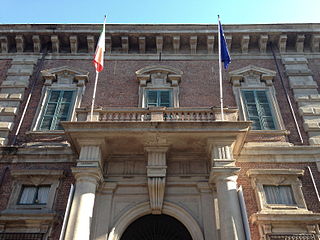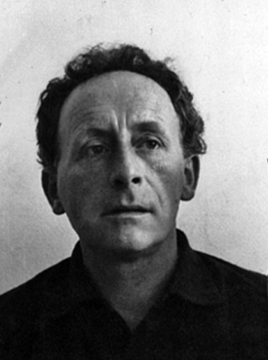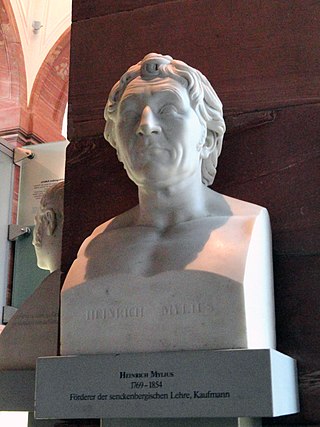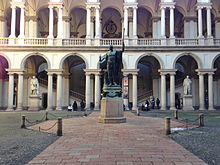
The Accademia di Belle Arti di Firenze is an instructional art academy in Florence, in Tuscany, in central Italy.

Pietro Consagra was an Italian sculptor. In 1947 he was among the founding members of the Forma 1 group of artists, who advocated both Marxism and structured abstraction.

The Accademia Carrara,, officially Accademia Carrara di Belle Arti di Bergamo, is an art gallery and an academy of fine arts in Bergamo, in Lombardy in northern Italy. The art gallery was established in about 1780 by Giacomo Carrara, a Bergamasco collector or conoscitore of the arts. The academy of fine arts was added to it in 1794. The school was recognised by the Ministero dell'Istruzione, dell'Università e della Ricerca, the Italian ministry of education, in 1988 and in 2023 merged with the Conservatorio Gaetano Donizetti to form the Politecnico delle Arti di Bergamo.

The Pinacoteca di Brera is the main public gallery for paintings in Milan, Italy. It contains one of the foremost collections of Italian paintings from the 13th to the 20th century, an outgrowth of the cultural program of the Brera Academy, which shares the site in the Palazzo Brera.

Palazzo Brera or Palazzo di Brera is a monumental palace in Milan, in Lombardy in northern Italy. It was a Jesuit college for two hundred years. It now houses several cultural institutions including the Accademia di Brera, the art academy of the city, and its gallery, the Pinacoteca di Brera; the Orto Botanico di Brera, a botanical garden; an observatory, the Osservatorio Astronomico di Brera; the Istituto Lombardo Accademia di Scienze e Lettere, a learned society; and an important library, the Biblioteca di Brera.

The Accademia di Belle Arti di Bologna is a public tertiary academy of fine art in Bologna, in Emilia-Romagna in northern Italy. It has a campus in Cesena.

The Accademia di Belle Arti di Venezia is a public tertiary academy of art in Venice, Italy.
The Nuova Accademia di Belle Arti, "New Academy of Fine Arts", also known as NABA, is a private academy of fine art in Milan, in Lombardy in northern Italy. It has approximately 3000 students, some of whom are from abroad; it participates in the Erasmus Programme.

Giuseppe Pellizza da Volpedo was an Italian Divisionist painter.

Luigi Bisi was an Italian architect and painter. He was the most notable member of an artistic family.

Francesco Filippini was an Italian painter from Lombardy. He was much influenced by Tranquillo Cremona.

Giuseppe Amisani was an Italian portrait painter of the Belle Époque.
The Accademia di Belle Arti di Bari is a public tertiary academy of art in Bari, in Puglia in southern Italy. It was established on 1 October 1970 and was formally approved by presidential decree on 15 March 1973.

Santa Maria in Brera was a church in Milan, in Lombardy in northern Italy. It was built by the Humiliati between 1180 and 1229, given a marble façade and Gothic portal by Giovanni di Balduccio in the fourteenth century, and deconsecrated and partly demolished under Napoleonic rule in the early nineteenth century. The Napoleonic rooms of the Pinacoteca di Brera occupy the upper floor of what was the nave.
Lio Gangeri was an Italian sculptor.

Leoncillo Leonardi, commonly known as Leoncillo, was an Italian sculptor who worked principally in glazed ceramics, often large-scale, and often using vivid colours. Until the mid-1950s his work was mostly figurative, but became more abstract thereafter. In 1946 he was among the founding members of the Nuova Secessione Artistica Italiana, which soon became the Fronte Nuovo delle Arti. He received the Premio Faenza in 1954 and again in 1964, and won the sculpture prize at the Biennale di Venezia of 1968. His work was also part of the sculpture event in the art competition at the 1948 Summer Olympics.

The Premio Mylius was an Italian prize for painting. It was established by the Austrian industrialist Heinrich Mylius in 1841 and awarded by the Accademia di Brera in Milan, which at that time was under Habsburg rule. In 1856 there were two types of award, an annual prize of 700 Austrian lire for a painting in oils, and a biennial award of 1000 lire for fresco work. It was awarded until the outbreak of the Second World War.

Gustavo Frizzoni was an Italian art critic and art historian.
















